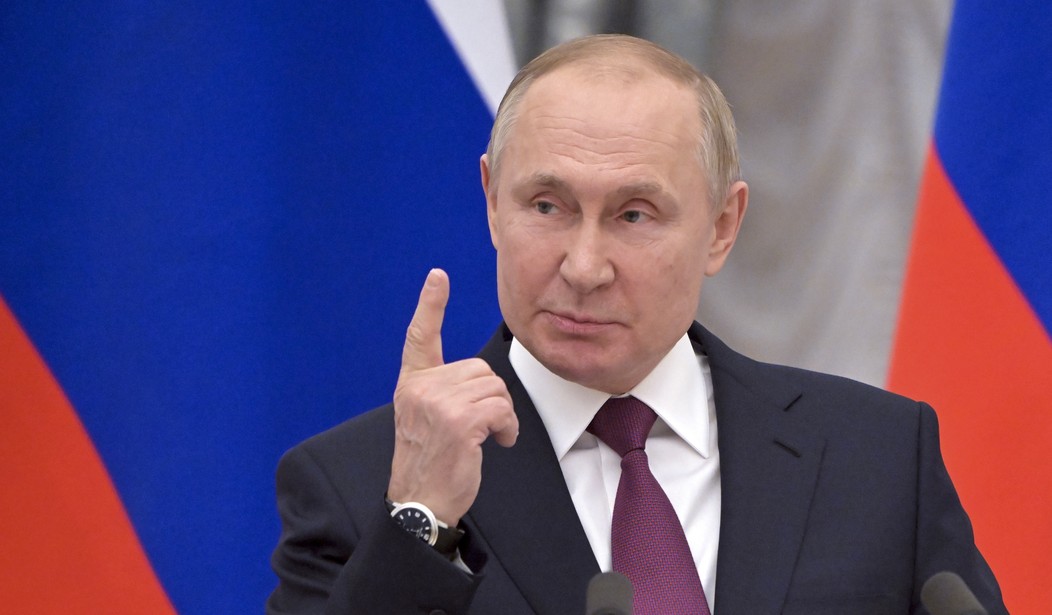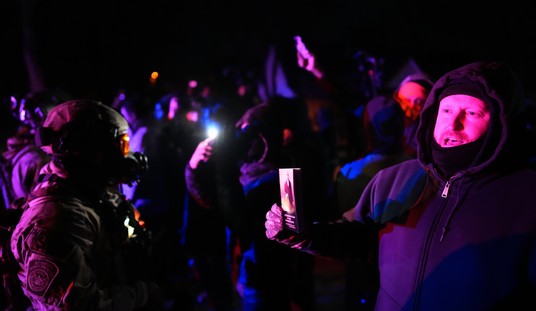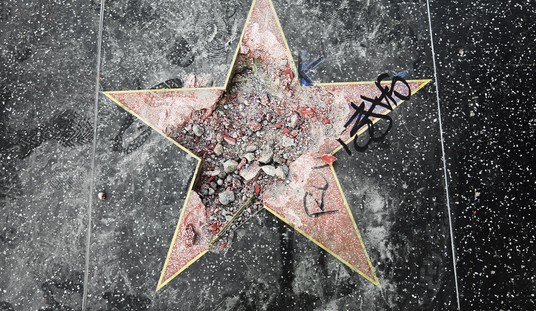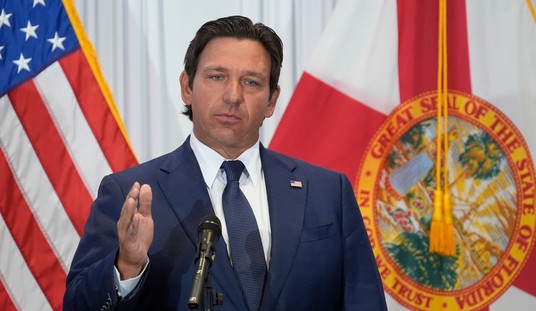Vladimir Putin’s imaginary war of liberation of Ukraine from so-called Nazi elements in the beleaguered country is entering its third week. The war has exposed flaws in the assumptions of world order that no one would have imagined possible only two weeks ago. The Russian excuse for being in Ukraine is also shifting.
In a report from Kyiv, freelance journalist Hollie McKay penned a report that appeared in the New York Post titled, Russian troops insist to Ukrainian that real target of war is ‘USA inside Ukraine’. In the piece, McKay reports,
Russian troops insisted that their real target is the US, not Ukraine, after they opened fire on a Ukrainian man trying to flee his war-torn town, the traumatized resident told The Post.
“We’re not at war with Ukraine and Ukrainians, but at war with the USA inside Ukraine,” 55-year-old Igor Sitalo said Russian soldiers told him after they shot at him.
Sitalo was fleeing his hometown of Hostomel, a city of 16,000, with his German shepherd, Ralph, on Sunday when a bullet struck his hand, grazed his head — and killed his canine companion.
This shift in rhetoric moves away from vilifying Ukrainians and back to the “Empire of Lies” accusation that Putin made in his 5:00am Moscow Time television announcement of his “special military operation” on February 20, 2022. This rhetoric has now been escalated by Russia formally asking the United Nations to investigate labs in Ukraine being US-sponsored bioweapon research facilities.
But the mighty Russian military has turned out to not be as mighty as its reputation. The war has moved away from an assumption that taking Ukraine was a simple affair, where the Russians would be welcomed with open arms as heroic saviors, as that assumption has turned out to be false. Mounting losses of men and equipment have revealed that technological advances in anti-tank technology in the hands of motivated defenders make military victory costly, and potentially impossible. Mr. Putin seems to have realized this, and has now declared that NATO shipments of weapons to Ukraine are legitimate military targets. Russia has also noticed that Ukraine is receiving an influx of volunteer fighters and is now beginning its own effort to bring in a foreign legion of its own, starting by recruiting fighter from war torn Syria.
Still, the Russian state media continues portray the invasion as an act of saving Ukrainians. Many Russians do not believe their military is destroying cities. Many other Russians know that it’s now a 15-year prison sentence to question the war openly.
I contacted Hollie to inquire about how well Mr. Putin’s propaganda machine is working from the perspective of someone seeing it at the receiving end of the Russian barrage. She shared this snippet about Mr. Sitalo’s experience with his relatives in Russia, as an example of how the Russian propaganda machine is working.
The evacuees like Igor have been brought to a “transition point” called Bilohorodka, a small village around 14 miles west of Kyiv city. On Wednesday alone, the convoys brought around 800 civilians, mainly from the hard-hit towns of Irpin, Bucha, Vorzel, Hostomel, and Borodianka. Many have been living breathlessly in their bunkers for more than a week without electricity, heating, food and medicines as their homes were butchered and battered above. From this point, individuals can receive medical care and nutritional supplies before having to configure where on the earth they can run from here.
Nowhere is safe, and officials say they worry that the Russians will even assault the makeshift departure point when the ceasefire ends at midnight Wednesday.
Later, I spot Igor alone in the volunteer medical tent, staring glumly at the floor. He flicks through his dying phone and shows me the string of images he sent to friends and associates in Russia, his bullet-ravaged flesh raw and oozing.
“Still, they do not believe me,” he says bitterly. “They do not believe I am injured; they do not believe Russians are doing these things. In a post in one of our aviation groups on Facebook, I wrote, ‘Brother Russians, what the f*ck are you doing? Why are you doing this?’”
Cultural Factors
I’ve spoken with other Russian friends about this phenomenon, and there is indeed a deep wound in the Russian psyche that goes back to the ending of the Cold War. We in the West look at the actions of Soviet leaders like Mikhail Gorbachev as heroic pioneers opening an opportunity for world peace. But Russians don’t like Mr. Gorbachev. Many see him as selling his country out to the West; an act that led to the end of the Soviet Union in an economic collapse in the mid-90’s, where many Russians suffered severe hardships. It was this tragedy that brought Vladimir Putin to power. His leadership slowly brought the Russian Federation back onto the world scene as a military and economic power. They are grateful to him for it, and hesitant to believe that he could be throwing it all away in a brash act against Russia’s Ukrainian brothers.
But Mr. Putin is throwing it all away. He’s turning Russia into a hermit kingdom like North Korea, and he’s taking the Russian people down with him. His actions are on a path that will herald another deep, economic collapse of Russia and the return of the severe hardships of the 1990s. He’s undone all that he did for his country. It’s sad. Quite honestly, the Russian people deserve better. Soberly, this is a leadership problem only they can solve for themselves.
Back in the Trenches
In the meantime, the West must find a way to prevent Ukraine from vanishing. It’s important to do so now, because letting Ukraine fall is an existential threat to the international system of free trade that the United States, Europe, and even China, have worked to build since the end of World War II. Cutting off the geographic center of Eurasia from the rest of the world’s economy changes the entire design of global infrastructure. Not just above the table in commerce and banking, but in the murky world of power and alliances. Already we see talk of Iran and Venezuela being invited back into the league of nations to replace Russia. That’s just the beginning of changes to come.
Russian logistics planning has become more complicated than the general staff anticipated. Scenes of commercial vehicles on trains being rushed from Russia to Ukraine appear on the internet — revealing a fact, that Russian military hardware is no longer enough to sustain forces in the field. The harsh reality for the Russian high command is also setting in; they simply won’t be able to afford to permanently occupy Ukraine, which is the size of Texas, over the long term against an insurgency of 44 million people.
So, Vladimir Putin looks to be going back to his favorite, cruel strategies, channeling methods of old empires that would routinely sweep through Eurasia destroying everything in their path to “pacify” the conquered regions, so they would not be a threat to their homeland. At the end of two weeks, the Russian campaign turns to the state-sponsored terrorism of siege warfare, as civilians become part of the target list of Russian aircraft, missiles, and artillery. He’s doing precisely what Mr. Sitalo’s relatives in Russia are in denial of.
Prior to this phase, the Russian generals were clearly trying to avoid civilian casualties. They initially offered to accept the surrenders, almost always refused. They seemed to be going to great lengths in being selective about targets. Such careful measures rarely survive first contact with a determined foe, and the Ukrainians have turned out to be quite determined.
The Ukrainians have also turned out to have a far better form of military organization than the Russians. Despite decades of modernization, the Russian military remains a top-down command and control system that relies on a centralized general staff making decisions that are expected to be carried out by operatives in the field. This form of command works well in peacetime, when it’s mostly table top and field exercises; but it tends to falter when the real shooting starts, because exercise ground rules and assumptions have this nasty habit of being meaningless to the behavior of one’s enemies.
The Ukrainians have a more distributed command and control system, where senior leaders provide broad guidance, logistical support, and determine when, or when not to, commit reserves. The actual field decisions by the Ukrainian military, as is common to the professional militaries of the US and NATO allies, is to enable decisions by field commanders spreading responsibility throughput the ranks including generals, colonels, captains, lieutenants, and sergeants.
When these two forms of command structure meet, the distributed command one typically can adjust tactics better per engagement cycle than the top-down one. The top-down one typically tries a plan that either succeeds or fails, then makes major changes at the general staff level, and tries again. We are certainly seeing this pattern show up in Ukraine. But the Ukrainians also have their own military capability and logistics limits. The Russians know this. And Mr. Putin is well practiced in the artform of beating former Soviet republic populations to a pulp.
Keeping the Russian Horde at Bay
For the last week, observing Western analysts pondering what the US and the West can do now has been interesting. The debate about fighter aircraft being supplied to Ukraine has been on the front burner of pundits. Western nations have offered their aircraft, and the US has been the principal naysayer to the transfer. I agree with the US hesitancy for two reasons.
First, augmenting Ukraine’s air force with a few planes right this minute is a token gesture. It has little leverage. It may create contested airspace over the skies of Ukraine temporarily, but the Russian air force far outnumbers Ukraine’s, and attrition will eat this valuable resource all too soon.
It’s not a substitute for implementing a real “no fly” zone over Ukrainian airspace. That type of operation requires best of breed fighters that can actually sweep the air clean, and all of the command-and-control systems that go along with it. That’s also an escalation step that the US is hesitant to take.
The other reason for this hesitancy is more ominous. The US is afraid that Vladimir Putin is an unstable man capable of pressing the mushroom button; that his rhetoric to escalate to the use of nuclear weapons is not idle. The reasons for this are speculative. I’ve heard everything from assertions that Putin is a genius who knows exactly how to rattle and neuter Joe Biden in a game of nuclear brinkmanship, to rumors that the Russian leader is suffering a condition which may have affected his ability to think rationally. Exactly what the reality may be is the great unknown in the West. The US is clearly erring on the side of caution. For now, the Kremlin’s inner leadership is closed lipped, marching in lock step, and remaining intensely loyal to the Russian strongman.
As to the fighter aircraft, there is an argument that says it’s better to position these aircraft as a strategic reserve that can be brought to bear when Ukraine’s forces find an opportunity to counterattack and break through against the Russian army on the ground. That is when transferring these aircraft will have leverage out of proportion to their numbers. That’s what you do with reserves. The optics look bad, though.
In the meantime, other analysts have pointed out avenues of assistance that Ukraine can use to keep the Russian war machine at bay. Looking at supplying Ukraine weapons and other equipment that can engage Russian rear areas and logistics supply lines grows in importance. This element of war is known as follow on forces attack (FOFA), and is a known Russian soft spot.
Weapons that can increase the capability to put the Russian navy at greater risk, up to systems that can threaten the success of naval bombardment and amphibious landing capability, are another line of thinking in the analyst community that also seems to have merit, particularly as the Russians close on places such as Odessa.
Getting these systems to Ukraine now that Russia has declared the Western supplies as legitimate military targets adds a new twist to the problem. The big question for the West that I’d ask is, are supplies sitting in Poland, or Germany, or in the US, legitimate military targets in Mr. Putin’s mind? Are Polish Air Force Mig-29’s that have been offered but not transferred still in that NATO country’s military considered legitimate targets. Will he hit us? Will we shoot back? Will that invoke Article 5? Does Mr. Putin care if it does? Does he want to trigger it the way he’s asked Russia’s Collective Security Treaty Organization (CSTO) to supply forces? New week, new worry beads.
Back Channels
Even as the US ramps up pressure on Russia, a parallel back channeling process is needed, aimed at Kremlin insiders, ordinary Russians, and CSTO countries. The Western message needs to be that we are ready and willing to welcome them back into the global community of nations, if they sort out their leadership’s misguided agenda. This is vital, particularly so with Putin’s pattern of ramping up the pressure that will eventually reach open war between East and West as the only conclusion that might satisfy his thirst. We should be exploring every avenue of getting this message through.
But there’s a warning here. We must mean it. We must be ready to back that promise up, because the Russians will be able to tell if we are selling smoke and mirrors stories. Putin will attempt to thwart every overture we make. He created his own trap to the point that he can’t afford to lose or compromise anymore.
There need to be exit narratives, once this war ends and the Russian government is back in good order. There are a lot of studies right now about how to contain Russia. We talk about the stick. But there are few concrete steps the West is also planning… a carrot. That narrative needs to begin to permeate through the wall of intimidation that Mr. Putin has imprisoned his entire sphere of influence within.
The truth is that it’s already clear to all who are being asked to support Mr. Putin’s invasion that their dreams of a better future will be ending in a repeat of the mid-90’s economic disaster that brought him to power. Convincing them to make the change that prevents this reversion is the biggest diplomatic mission the entire world needs to make important.













Join the conversation as a VIP Member